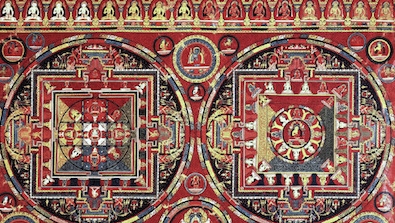
Tasked with taking in as much art as possible in a finite amount of time, museum visitors spend an average of just 15–30 seconds viewing single pieces of art, according to the New York Times. But what would happen if viewers slowed down? What would be the effect of looking at fewer works for a longer period of time?
These questions prompted Phil Terry, founder of the Reading Odyssey, to conduct a 2008 experiment in which he viewed a few works of art—rather than an entire exhibition—at the Jewish Museum for an extended period of time. His trial, which Terry found to be invigorating, has since evolved into Slow Art Day, an annual global event that boasts more than 100 museum and gallery participants.
The Rubin Museum is pleased to participate in this year’s iteration of Slow Art Day, which takes place this Saturday. We invite art and culture aficionados, creative thinkers, and curious minds to join us for a special Slow Art Tour at 4:00 PM, or to stop by the Museum anytime between 11:00 AM and 6:00 PM to explore the galleries at a leisurely pace and spend quality time with five pieces of art that catch their eye.
In preparation for Saturday’s tour, we’ve asked Rubin staffers from across the Museum to share an artwork from the collection that inspires them to look slowly and think deeply. We hope you enjoy reading about their selections and that you’re able to make personal connections with artworks from our collection during your next visit to the Museum.

“It reminds me of Mexican Folk Art. I love the detail in the little carved animals.”—Katy Uravitch, Exhibitions Manager/Curatorial Administrator

“I think of mandalas as great fortifications that you must penetrate, but not like a knight in shining armor. Counter-intuitively, perhaps, you become stronger, closer to the center of the mandala, if you shed yourself of the conventional armor of personality; divest yourself of ignorance, desire and hatred. The password to penetrate the inner sanctum is not ‘open sesame’ but open mind.”—Tim McHenry, Director of Public Programs and Performance
“The structure of the piece allows imagining of a dimensional entity; one can fall into the piece, the space.”—Fabiana Weinberg, Exhibition Design Assistant

“The Durga Mahisasuramardini radiates a powerful and dynamic energy that draws me to the sculpture every time I enter the gallery. It is a beautiful example of Nepalese artistry.”—Michelle Bennett Simorella, Head of Collections Management and Registration

“Ever since I was a very little boy watching my grandfather build my sister and I a playhouse I’ve been fascinated with woodworking. The skill and dedication needed to carve a wooden torana of this size with every single square inch detailed with fascinating little intricacies is mind boggling to me.”— Albert Siebenaler, Manager of Operations, Security & Housekeeping

“As a graphic designer it’s fun for me to contemplate the visual interpretation of the mandala palaces into such elegantly codified 2-dimensional graphic symbols. The intricately decorated surface of the painting seems to intentionally deny the third dimension, but if you look at the piece with an understanding of the painting’s purpose, you can see the fully-dimensional palaces.”—Andrea Pemberton, Creative Manager of Graphics and Branding

“This object encapsulates common themes that define many of the works on view at the Rubin, a museum focusing on a region where horses are essential to traverse the often mountainous terrain; on disparate cultures where treasured materials, such as gold and silk, are part of daily life and trade; and on the symbolism of the lotus flower.”—Bill Appleton, Director of Education & Engagement

“I feel extremely close to this piece. The brushstrokes, the soft, wispy quality of the rocks, water, and plants make me feel like I can smell the mossy, watery environment.”—Olivia Buscarino, Teen Program Coordinator

“It has so many details, even though the sculpture is quite small. The face, the posture, the whole object is exquisite. And it depicts a youthful deity who is in waiting to become the next Buddha.”—Elena Pakhoutova, Curator, Himalayan Art
For more information on Slow Art Day, please visit SlowArtDay.com.
Add Your Thoughts
Comments are moderated, and will not appear on this site until the Rubin has approved them.

